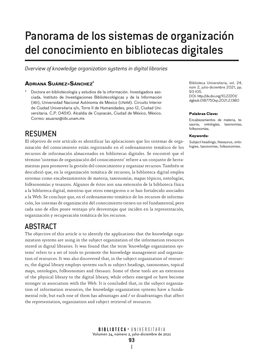Overview of knowledge organization systems in digital libraries
DOI:
https://doi.org/10.22201/dgbsdi.0187750xp.2021.2.1380Keywords:
Subject headings, thesaurus, ontologies, taxonomies, folksonomiesAbstract
The objective of this article is to identify the applications that the knowledge organization systems are using in the subject organization of the information resources stored in digital libraries. It was found that the term ‘knowledge organization systems’ refers to a set of tools to promote the knowledge management and organization of resources. It was also discovered that, in the subject organization of resources, the digital library employs systems such as subject headings, taxonomies, topical maps, ontologies, folksonomies and thesauri. Some of these tools are an extension of the physical library to the digital library, while others emerged or have become stronger in association with the Web. It is concluded that, in the subject organiza- tion of information resources, the knowledge organization systems have a funda- mental role, but each one of them has advantages and / or disadvantages that affect the representation, organization and subject retrieval of resources.
Downloads
References
Chaudhry, Abdus Sattar y Jiun, Tan Pei. Enhancing access to digital information resources on heritage: a case of development of a taxonomy at the integrated museum and archives system in Singapore. Journal of Documentation, 2005, vol. 61, no. 6, p. 751-776.
Chowdhury, Gobinda, Chowdhury Sudatta. Organizing information: from the shelf to the web. Londres: Facet Publishing, 2007. 227 p.
Digital Library Federation. Digital Library Federation [en línea]. <https://www.diglib.org/> [Consulta: 1 abril 2021].
Dirección General de Bibliotecas y Servicios Digitales de Información, Universidad Nacional Autónoma de México. Descubridor de información [en línea]. <https://dgb.unam.mx/>. [Consulta: 1 abril 2021].
Dos Santos, Raimunda Fernanda y Fernandes, Renato. Modelos colaborativos de indexação social e sua aplicabilidade em bibliotecas digitais. Liinc em Revista, 2015, vol. 11, no. 1, p. 273-286.
Gnoli, Claudio. 2015. Knowledge organization systems (kos). En Golub, Koraljka Subject access to information: an interdisciplinary approach. Santa Bárbara, California: Libraries Unlimited. p. 43-65.
Golub, Koraljka, Schmiede, Rudi y Tudhope Douglas. Recent applications of knowledge organization systems: introduction to a special issue. International Journal on Digital Libraries, 2019, vol. 20, p. 205-207.
Hatfield, Amy y Kelley Shana D. Case study: lessons learned through digitalizing the national commission for the protection of human subjects of biomedical and behavioral research collection. Journal of Medical Library Association, 2007, vol. 95, no. 3, p. 267-270.
Hodge, Gail. Systems of knowledge for digital libraries: beyond traditional authority files. Washington: Council on Library and Information Resources, 2000. 37 p.
International Federation of Library Associations and Institutions (ifla).
Functional requirements for subject authority data (frsad) [en línea]. <https://www.ifla.org/files/assets/classification-and-indexing/functional-requirements-for-subject-authority-data/frsad-final-report.pdf>. [Consulta: 1 abril 2021].
Kahn, Charles. E. A digital library of radiology images. amia: annual symposium proceedings. Washington: amia, 2006, p. 972.
Kumbhar, Rajendra. Library classification trends in the 21st century. Oxford, Reino Unido: Chandos, 2012. 172 p.
Maculan, Benildes y Lima, Gercina. Faceted taxonomy for accessing digital libraries. En Qualitative and Quantitative Methods in Libraries, 2014, vol. 1, p. 331-341.
Martínez Arellano, Filiberto Felipe. Retos de la catalogación y los catálogos. Investigación Bibliotecológica, 2012, vol. 26, no. 58, p. 7-12.
Matusiak, Krystyna K. Towards user-centered indexing in digital image collections. oclc Systems & Services: International digital library perspectives, 2006, vol. 22, no. 4, p. 283-298.
Mishra Surjeet y Ghosh, Hiranmay. Ontology-based visualization and navigation in an online digital library. World Digital Libraries-An International Journal, 2010, vol. 3, no. 1, p. 41-49.
Monroy, Carlos, Furuta, Richard y Castro Filipe. Using and ontology and a multilingual glos- sary for enhancing the nautical archaeology digital library. En Proceedings of the 10th annual joint conference: digital libraries. Nueva York: Association for Computing Machinery, 2010, p. 259-262.
Nilbe, Sirje y Tarkpea, Tiiu. Using the Estonian subject thesaurus in the digital environment. Cataloging & Classification Quarterly, 2013, vol. 52, no. 1, p. 32-41.
Peña Vera, Tania. Organización y representación del conocimiento: incidencias de las tecnologías de la información y la comunicación. Buenos Aires: Alfagrama, 2011, 314 p.
Pepper, Steve. Italian opera topic map [en línea]. <https://ontopia.net/omnigator/models/topicmap_complete.jsp?tm=ItalianOpera.ltm>. [Consulta: 1 abril 2021].
Shiri, Ali. Digital library research: current developments and trends. Library review, 2003, vol. 52, no. 5, p. 198-202.
Shiri, Ali, Ruecker Stan, Fiorentino, Stafford, Carlos, Bouchard Matthew y Bieber, Mark. Design a semantically rich visual interface for cultural digital libraries using the unes- co multilingual thesaurus. Proceedings Cultural Attitudes Towards Communication and Technology, 2010, p. 45-52.
Shiri, Ali y Chase-Kruszewski, Sarah. Knowledge organisation systems in North American digital library collections. Program electronic library and information systems, 2009, vol. 43, no. 2, p.121-139.
Tramullas, Jesús. Propuestas de definición y concepto de la biblioteca digital. En III Jornadas de bibliotecas digitales. Madrid: Universidad Politécnica de Madrid, Grupo de Ingeniería del Software, 2002, p. 11-20.
Tudhope, Douglas y Nielsen, Marianne. Introduction to knowledge organization systems and services. New review in hypermedia and multimedia, 2007, vol. 12, no. 1, p. 3-9.
Walsh, John. The use of library of congress subject headings in digital collections. Library Review, 2011, vol. 60, no. 4, p. 328-343.
Zeng, Marcia Lei. Knowledge organization systems (kos). Knowledge Organization, 2008, vol. 35, no. 2/3, p. 160-182.

Downloads
Published
How to Cite
Issue
Section
License
Descargar el formato de Cesión de derechos en formato PDF:
Formato de Cesión de derechos
Imprímalo y una vez que lo haya firmado envíenoslo vía fax o por correo a:
Revista Biblioteca Universitaria:
Dirección General de Bibliotecas y Servicios Digitales de Información de la UNAM
Departamento de Publicaciones
Edificio de la Biblioteca Central, 11o Piso,
Circuito Interior, Ciudad Universitaria, 04510 México, D.F.
Tel 5622-1616,
Fax: 5622-1601,






